The energy supply to heat the homes of our grandchildren
remains uncertain. The options available to us have been
detailed by David Mackay in his readable book Sustainable
Energy, Without the Hot Air [1]. Mackay describes how at present
we use around 125KWh per day per person, produced largely
by CO2-emitting coal, oil and gas. There is now no doubt that
climate change is with us. As David King, our Chief Scientist from
2000 to 2007, said: "Climate change is the most severe problem
that we are facing today, more serious even than the threat of
terrorism." We have to change our ways. There is solar and wind
energy, but the sun does not always shine nor the wind always
blow. There is nuclear fission energy, which the UK pioneered
and which has served us well, but it is not without risk and its
public acceptance is fragile. Fusion is one remaining option for a
sustainable, safe, CO2-free, base-load energy source (Figure 1).
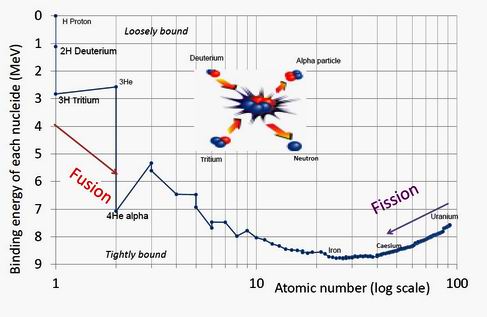 Figure 1: Nuclear power from fusion and fission. The graph
shows the excess energy of different nuclei plotted against
atomic mass. The very light atoms have a high excess energy
and can become more stable by fusing together to produce
larger nuclei. Heavy nuclei can become more stable by splitting
up to produce fission products of intermediate mass.
Figure 1: Nuclear power from fusion and fission. The graph
shows the excess energy of different nuclei plotted against
atomic mass. The very light atoms have a high excess energy
and can become more stable by fusing together to produce
larger nuclei. Heavy nuclei can become more stable by splitting
up to produce fission products of intermediate mass.
The fusion reaction
Nuclear fusion is the reaction that powers our Sun. The fuel is
hydrogen nuclei, protons, deuterons (D) and tritons (T). In the
heat and gravitational 'bottle' of the Sun, these can be forced to
overcome their electrostatic repulsion and join together to form
the stable helium nucleus - or alpha particle - and a neutron
(n), together with a great deal of energy: 14MeV flies off in the
neutron, which may be used to heat up a water jacket to make
electricity; the charged alpha particle, with 3.6 MeV of energy,
remains in the plasma, giving up its energy and helping to sustain
the following reaction.
2D+3T = 4He+n +17.6MeV
There are important differences in the safety issues for nuclear
fission and fusion (Figure 2). At Chernobyl, the criticality accident
only occurred because a fission reactor contains large reserves
of fuel. In a fusion reactor the hydrogen fuel is continuously
injected into the plasma so that it can only sustain fusion for
seconds, and a 'criticality' accident is impossible. At Fukishima
the reactor was properly shut down, but the meltdown occurred
because spent fuel continues to produce heat, which could not
be removed because of the flooded back-up generators. There is
no such 'delayed' heat in a fusion reactor. At Three Mile Island,
human error caused the meltdown but the problem was the high
reactivity of the long-lived fission products that were allowed to
escape. The fusion products are the benign helium and neutrons.
The neutrons produce some activation in the structural materials,
but with the correct choice of alloy materials this is a minor
issue compared with the fission spent fuel which has proved so
expensive to deal with.
 Figure 2: The three accidents that changed public acceptance of fission power. In a fusion reactor there is no possibility of the
'criticality' at Chernobyl (a), the release of highly active 'fission products' at Three Mile Island (b), or the 'delayed heat' at Fukashima (c)
Figure 2: The three accidents that changed public acceptance of fission power. In a fusion reactor there is no possibility of the
'criticality' at Chernobyl (a), the release of highly active 'fission products' at Three Mile Island (b), or the 'delayed heat' at Fukashima (c)
In defence of fission it must be said that the public mind tends
to over-estimate the actual deaths and premature deaths (56
and 4000 respectively from Chernobyl according to Wikipedia),
compared with, say, the seven million premature deaths per year
estimated by the World Health Organisation to result from air
pollution [2].
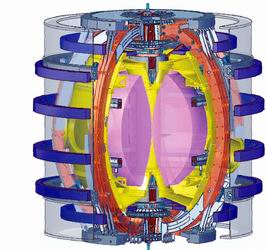 Figure 3: The ST40 tokamak. The plasma (violet) is the elongated
toroid. The white coils produce the toroidal field along the
direction of the plasma which helps to stabilise it. The blue coils
produce the vertical fields that shape and help form the plasma.
Wound around the brown central column is a solenoid that also
helps drive the plasma current.
Figure 3: The ST40 tokamak. The plasma (violet) is the elongated
toroid. The white coils produce the toroidal field along the
direction of the plasma which helps to stabilise it. The blue coils
produce the vertical fields that shape and help form the plasma.
Wound around the brown central column is a solenoid that also
helps drive the plasma current.
The tokamak magnetic bottle
In order to make the fusion reaction work on Earth, the
gravitational confinement operating in the Sun must be
reproduced in some way. The tokamak (Russian for magnetic
bottle) provides a magnetic confinement that is able to hold the
high-temperature plasma away from all walls. Figure 3 shows the
typical tokamak design, specifically the ST40 spherical tokamak
being built at Tokamak Energy. (Conventional tokamaks have a
wider, ring-doughnut shape but similar configuration.) It has a
toroidal vacuum chamber containing the plasma, and toroidal
coils which produce a strong field parallel to the plasma direction.
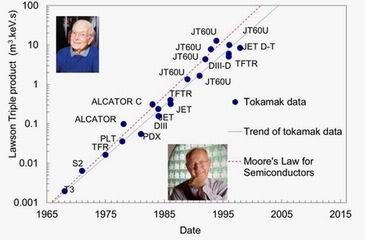 Figure 4:The historical increase in the fusion Lawson 'triple
product'. For three decades until 1997 the fusion triple
product increased exponentially (points and blue line) with
around a two-year doubling time, almost the same as the
Moores's law for semiconductors (red dashed line). Only the
JET and TFTR data points used tritium fuel, the other points
are extrapolations from deuterium plasmas.
Figure 4:The historical increase in the fusion Lawson 'triple
product'. For three decades until 1997 the fusion triple
product increased exponentially (points and blue line) with
around a two-year doubling time, almost the same as the
Moores's law for semiconductors (red dashed line). Only the
JET and TFTR data points used tritium fuel, the other points
are extrapolations from deuterium plasmas.
Since the earliest ZETA days a key problem of plasma physics has
been the stability of the plasma. Any contained plasma must be
'pinched in' away from the container walls; however, the plasma
column wiggles about and tends not to be stable. In a tokamak
the toroidal coils form a strong magnetic field along the plasma
path, which tends to improve its stability.
How can progress towards fusion be measured? One answer
was given by John Lawson in 1955 who, while working at
Culham, devised the 'Lawson triple-product':
nTtE > 221 m-3keVs
where n is the plasma density, T is the plasma temperature in keV,
and tE
is the plasma 'energy confinement time', i.e. the mean
time for energy to diffuse away from the plasma.
Figure 4 shows the increase in fusion triple product from
the first T3 tokamak in Russia to the JET tritium runs in 1997.
A doubling time of around two years was achieved largely by
building ever-larger tokamaks. The JET tokamak has a major
radius of three metres and achieved some 16MW of fusion power.
Those were exciting days! Figure 5 shows the neutron emission
profile as modelled from the nine vertical and ten horizontal
neutron counters measuring the neutron emission profile along
the lines shown [3].
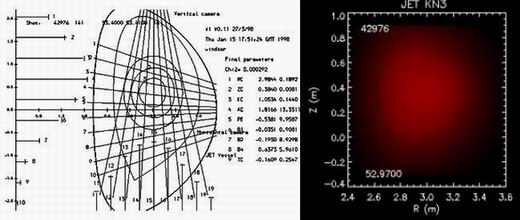 Figure 5:The recordbreaking shot 42976 on JET. On the right is
a reconstruction of the neutron emission as measured by the vertical
and horizontal neutron cameras [3].
Figure 5:The recordbreaking shot 42976 on JET. On the right is
a reconstruction of the neutron emission as measured by the vertical
and horizontal neutron cameras [3].
What can the physics say?
The increasing triple product curve stops at 1997, as the whole
world looks forward to the ITER project with its 6.2 metre major
radius. Its centre column alone weighs more than the Eiffel tower.
The project is funded by Europe, Japan, Russia, USA, China,
South Korea and India, and we all eagerly await its answers to the
unknown conditions of a burning plasma. But ITER has already
shown us that building bigger has its own problems. Can there
be quicker way by building more compactly, to produce smaller
power plants better suited to the energy market? The physics tells
us of options that were not available in the 1990s when ITER was
designed. The fusion power (Pfus) can be written as
Pfus ~ b2BT4V
where b
is the plasma pressure, Bt is the toroidal field
and V is the volume. The
ITER design had the conventional JET shape, largely defining
the plasma pressure, and used the best low-temperature
superconducting magnets available to give the highest possible
toroidal field. Increasing the volume was the only option available
then.
 Figure 6: Two developments from the 1990s: (left) the START spherical tokamak; (right) the high-temperature
superconducting 'REBCO' tape.
Figure 6: Two developments from the 1990s: (left) the START spherical tokamak; (right) the high-temperature
superconducting 'REBCO' tape.
There were two developments in the 1990s which changed
this. First, the START spherical tokamak at Culham, shown on the
left of Figure 6, demonstrated that making the plasma the shape
of a cored apple rather than a doughnut could give a higher
plasma pressure. Secondly, the discovery of 'high-temperature'
superconducting materials showed that the magnetic fields on
the plasma could be much higher than previously thought. The
right of Figure 6 shows the cross-section of the high-temperature
superconducting tape. Most of the tape is copper stabiliser and
substrate. The superconducting layer is only one micron thick.
 Figure 7: The Tokamak Energy team at Milton Park.
Figure 7: The Tokamak Energy team at Milton Park.
TokamakEnergy.co.uk
Tokamak Energy was founded by the START pioneers Alan Sykes
and Mikhail Gryaznevich, with David Kingham as chief executive
officer. With just a small number of UK investors who actively
guide the company, and the relatively tiny number of staff shown
in Figure 7, it has been able to forge an alternative path to fusion
energy based on rapid development using small prototypes. At
their premises in Milton Park in Oxfordshire a small test tokamak,
ST25, has been built to investigate innovative solutions to the key
problems of novel controllable power supplies, plasma start-up
and efficient plasma current drive.
A key challenge in the development of compact fusion is how
to make reliable, high-field high-temperature superconducting
(HTS) magnets. Their operation is quite different from conventional
low-temperature superconductors. They can operate at 77K liquid
nitrogen temperatures rather than 4K helium temperatures, but
much higher fields can be generated if they are cooled to about
20K with helium, hydrogen or neon coolants. At present they are
not available in the kilometre lengths required for a power plant.
New methods for joining them have recently been developed in
house: they involve using hair straighteners, which have exactly
the right temperature-controlled flat surfaces to bond the tapes
nicely together. The quench properties of the HTSs are also quite
different: they seem less prone to the catastrophic quench events
that can occur with conventional superconductors. To test these
technologies, the ST25HTS tokamak has been built at Milton Park.
During July 2015, during the Royal Society Summer Exhibition, it
was run successfully at Milton Park for over 24 hours, as shown in
Figure 8.
 Figure 8: Our small tokamak with hight-temperature superconducting (HTS) magnets, ST25HTS,
hold a plasma for 29 hours, demonstrating the feasibility of HTS for tokamaks.
Figure 8: Our small tokamak with hight-temperature superconducting (HTS) magnets, ST25HTS,
hold a plasma for 29 hours, demonstrating the feasibility of HTS for tokamaks.
A key objective of Tokamak Energy is to design a pilot plant that
would be small enough to manufacture as the first of a series of
units that could be developed incrementally, and linked together
to form a modular power station. This would provide continuity
of supply, economy of mass production and other practical
advantages. The key requirement is that each module should
produce a high gain Qfus in fusion power, where Qfus = power
released/power in.
But how small could the base module be? What are the limiting
factors? What can theory say? What experimental measurements
need to be done?
 Figure 9: The figure from the paper by Costley et al. [4]
showing that the fusion gain Qfus is only weakly dependent on
device size R but does depend on the fusion power.
Figure 9: The figure from the paper by Costley et al. [4]
showing that the fusion gain Qfus is only weakly dependent on
device size R but does depend on the fusion power.
A theoretical study by Alan Costley and colleagues [4] showed
that when the plasma was operated in a steady state within
reasonable fractions, say 0.8 of the Greenwald density limit and
0.9 of the Troyon beta limit, then the fusion energy gain (and
triple product) depends mainly on the absolute level of the fusion
power and the energy confinement, and only weakly on the device
size, as shown in Figure 9. Further, they showed that the scaling
law used to design ITER needs to be updated. In particular, a betaindependent
scaling is needed to account for recent experiments.
This approach suggests that there is no problem with the
physics of smaller tokamaks. But what about their engineering?
It has long been realised that the slender centre column of the
spherical tokamak is a problem. If made of superconductors they
must be surrounded by a neutron shield, both to reduce the heat
deposition and to reduce radiation damage. If made, instead, of
copper, the ohmic heating is large. Either much energy must be
wasted cooling the centre column, or its temperature must be
allowed to rise during the experiment. This last solution is the one
chosen for ST40, a larger machine under construction by Tokamak
Energy. It is designed to be the world's highest field spherical
tokamak and to establish the physical properties of these plasmas.
ST40 will operate in hydrogen, and will not produce neutrons.
The copper resistivity is lowered by cooling to liquid nitrogen
temperatures, and a window of operation time several seconds
long is available as the centre column heats up from, say, 77K to
200K. Of course there follows several minutes of cooling down
before the next shot.
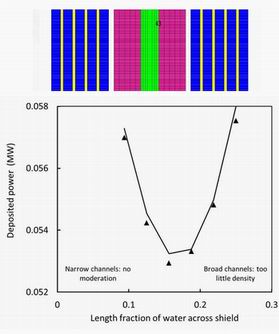 Figure 10: On the left is a section through the centre column of a
pilot plant tokamak with a tie-rod (green) in the centre then a high temperature
superconductor alloy (purple), a thermal gap (white) and layers of shield material
(blue) and water-cooling (yellow). On the right is the heat deposition as a function of the thickness of the water-cooling
layer.
Figure 10: On the left is a section through the centre column of a
pilot plant tokamak with a tie-rod (green) in the centre then a high temperature
superconductor alloy (purple), a thermal gap (white) and layers of shield material
(blue) and water-cooling (yellow). On the right is the heat deposition as a function of the thickness of the water-cooling
layer.
For a power plant, there are many high-energy neutrons
produced and this option is not possible. An efficient neutron
shield must be designed. This is not easy. The 14MeV fission
neutrons hitting its outer surface create cascades of high-energy
gamma rays which need heavy elements to attenuate them. The
fast neutrons bounce off these heavy elements and need light
elements to slow them down and give up their energy. The Monte
Carlo computations [5] have now been extended and it seems that
the energy deposition could become a manageable 36kW or so
using the shield comprising layers of tungsten carbide separated
by cooling water, illustrated in Figure 10. The graph shows that
the heat deposition increases if the water-cooling thickness is too
small, leading to poor moderation. If the water-cooling thickness is
too large there is insufficient gamma shielding. Better performance
is given when the water thickness close to the core is thicker
than that close to the plasma. Still better performance occurs if
the layer of tungsten carbide closest to the core is replaced by
tungsten boride, which can absorb the slower neutrons.
Towards a modular power plant
The power plant modelling by Costley et al. [4] suggested that a
possible optimum size would be with a major radius of 1.35m.
The 36kW of nuclear heating to the superconducting core could
be removed by a cryoplant of around 2MW, which is not an
unreasonable fraction of the 175MW fusion power. Such a pilot
plant is illustrated in Figure 11, which shows a design developed
in collaboration with Princeton Plasma Physics Laboratory, USA. It
is large enough to be attractive as a unit to a utility company, and
small and cheap enough to be constructed conventionally using
available finance.
 Figure 11: A possible modular fusion power plant designed
in collaboration with the Princeton Plasma Physics Institute in
the USA.
Figure 11: A possible modular fusion power plant designed
in collaboration with the Princeton Plasma Physics Institute in
the USA.
Tokamak Energy is breaking the problem of fusion down into
a series of engineering challenges. Our ST40 experiment will give
us the numbers, in particular the energy confinement time in
high-field spherical tokamaks, to design the plant without large
extrapolations. At present the HTS superconductors are expensive
but the technology is developing and their price coming down.
A big market will aid this development. Heat deposition and
stresses in the centre column remain a problem, but new materials
combining the advantages of shielding, strength and toughness
are being developed to cope with them. None of these problems
appear insuperable and fusion in small spherical tokamaks could
be possible quite soon.
References
1. MacKay, D. Sustainable energy, without the hot air www.
withouthotair.com
2. World Health Organisation (2014) New release, Geneva, 25
March 2014 www.who.int/mediacentre/news/releases/2014/
air-pollution/en/
3. Windsor, C.G. (1998) Validated neutron data for physics
studies and their use in tomographic reconstructions from
JET's DTE1 campaign. JET workpackage A14.2d report, F/PL/
WPA14.2d/CGW/1 March 1998
4. Costley, A.E., Hugill, J. and Buxton, P.F. (2015) On the power
and size of tokamak fusion pilot plants and reactors. Nucl.
Fusion 55, 033001
5. Windsor, C.G., Morgan, J.G. and Buxton, P.F. (2015) Heat
deposition into the superconducting centre column of a
spherical tokamak fusion plant. Nucl. Fusion 55, 023014
About the authors
Colin Windsor

Colin Windsor joined Tokamak Energy in 2013 after a career at Harwell working on materials
using neutrons. He came to Culham in 1994 to work on control of the COMPASS-D tokamak
and on the JET tritium campaign. He now works on the neutronics of high temperature
superconductor tokamaks.
Melanie Windridge

Melanie Windridge is a physicist, speaker, writer and communications consultant
to Tokamak Energy. Her PhD focused on vertical stability on the MAST tokamak at
Culham Centre for Fusion Energy. She has published an introductory book on fusion
called "Star Chambers" and a narrative science book called "Aurora".
Alan Sykes
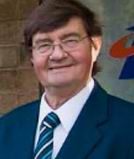
Alan Sykes is one of the founders of Tokamak Energy and a pioneer of the
spherical tokamak concept.
He had a fruitful career in fusion energy at Culham Laboratory from 1965 to
2008 spanning theory and experiment and leading on the record-breaking START
machine.
 Figure 1: Nuclear power from fusion and fission. The graph
shows the excess energy of different nuclei plotted against
atomic mass. The very light atoms have a high excess energy
and can become more stable by fusing together to produce
larger nuclei. Heavy nuclei can become more stable by splitting
up to produce fission products of intermediate mass.
Figure 1: Nuclear power from fusion and fission. The graph
shows the excess energy of different nuclei plotted against
atomic mass. The very light atoms have a high excess energy
and can become more stable by fusing together to produce
larger nuclei. Heavy nuclei can become more stable by splitting
up to produce fission products of intermediate mass.
 Nuclear Future, Volume 12, Issue 3, May/June 2016 ISSN 1745 2058
Nuclear Future, Volume 12, Issue 3, May/June 2016 ISSN 1745 2058
 Figure 2: The three accidents that changed public acceptance of fission power. In a fusion reactor there is no possibility of the
'criticality' at Chernobyl (a), the release of highly active 'fission products' at Three Mile Island (b), or the 'delayed heat' at Fukashima (c)
Figure 2: The three accidents that changed public acceptance of fission power. In a fusion reactor there is no possibility of the
'criticality' at Chernobyl (a), the release of highly active 'fission products' at Three Mile Island (b), or the 'delayed heat' at Fukashima (c)
 Figure 3: The ST40 tokamak. The plasma (violet) is the elongated
toroid. The white coils produce the toroidal field along the
direction of the plasma which helps to stabilise it. The blue coils
produce the vertical fields that shape and help form the plasma.
Wound around the brown central column is a solenoid that also
helps drive the plasma current.
Figure 3: The ST40 tokamak. The plasma (violet) is the elongated
toroid. The white coils produce the toroidal field along the
direction of the plasma which helps to stabilise it. The blue coils
produce the vertical fields that shape and help form the plasma.
Wound around the brown central column is a solenoid that also
helps drive the plasma current.
 Figure 4:The historical increase in the fusion Lawson 'triple
product'. For three decades until 1997 the fusion triple
product increased exponentially (points and blue line) with
around a two-year doubling time, almost the same as the
Moores's law for semiconductors (red dashed line). Only the
JET and TFTR data points used tritium fuel, the other points
are extrapolations from deuterium plasmas.
Figure 4:The historical increase in the fusion Lawson 'triple
product'. For three decades until 1997 the fusion triple
product increased exponentially (points and blue line) with
around a two-year doubling time, almost the same as the
Moores's law for semiconductors (red dashed line). Only the
JET and TFTR data points used tritium fuel, the other points
are extrapolations from deuterium plasmas.
 Figure 5:The recordbreaking shot 42976 on JET. On the right is
a reconstruction of the neutron emission as measured by the vertical
and horizontal neutron cameras [3].
Figure 5:The recordbreaking shot 42976 on JET. On the right is
a reconstruction of the neutron emission as measured by the vertical
and horizontal neutron cameras [3].
 Figure 6: Two developments from the 1990s: (left) the START spherical tokamak; (right) the high-temperature
superconducting 'REBCO' tape.
Figure 6: Two developments from the 1990s: (left) the START spherical tokamak; (right) the high-temperature
superconducting 'REBCO' tape.
 Figure 7: The Tokamak Energy team at Milton Park.
Figure 7: The Tokamak Energy team at Milton Park.
 Figure 8: Our small tokamak with hight-temperature superconducting (HTS) magnets, ST25HTS,
hold a plasma for 29 hours, demonstrating the feasibility of HTS for tokamaks.
Figure 8: Our small tokamak with hight-temperature superconducting (HTS) magnets, ST25HTS,
hold a plasma for 29 hours, demonstrating the feasibility of HTS for tokamaks.
 Figure 9: The figure from the paper by Costley et al. [4]
showing that the fusion gain Qfus is only weakly dependent on
device size R but does depend on the fusion power.
Figure 9: The figure from the paper by Costley et al. [4]
showing that the fusion gain Qfus is only weakly dependent on
device size R but does depend on the fusion power.
 Figure 10: On the left is a section through the centre column of a
pilot plant tokamak with a tie-rod (green) in the centre then a high temperature
superconductor alloy (purple), a thermal gap (white) and layers of shield material
(blue) and water-cooling (yellow). On the right is the heat deposition as a function of the thickness of the water-cooling
layer.
Figure 10: On the left is a section through the centre column of a
pilot plant tokamak with a tie-rod (green) in the centre then a high temperature
superconductor alloy (purple), a thermal gap (white) and layers of shield material
(blue) and water-cooling (yellow). On the right is the heat deposition as a function of the thickness of the water-cooling
layer.
 Figure 11: A possible modular fusion power plant designed
in collaboration with the Princeton Plasma Physics Institute in
the USA.
Figure 11: A possible modular fusion power plant designed
in collaboration with the Princeton Plasma Physics Institute in
the USA.


